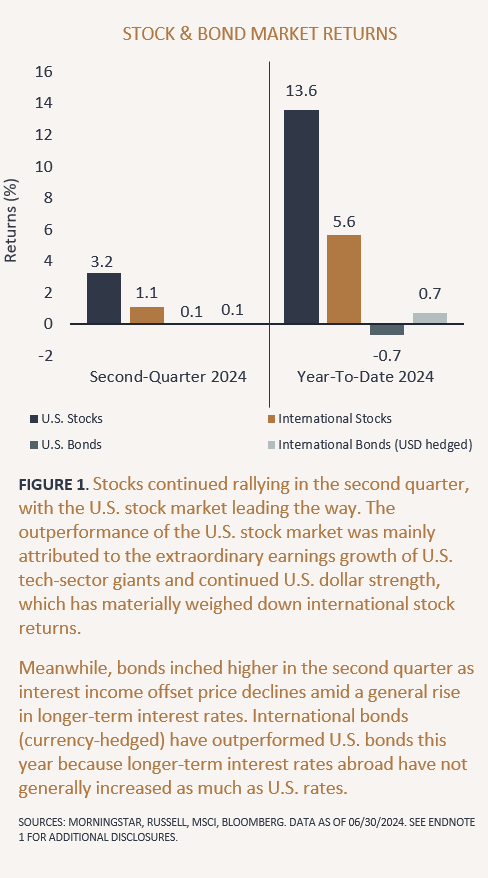Market Landscape: Record Heights, AI at the Core
By mid‑2025, the U.S. stock market closed at record highs. The S&P 500 rose about 7% year-to-date, led overwhelmingly by tech and AI-focused stocks, while broad optimism returned following the April tariff scare and Fed signals of easing
Nvidia, the AI chip giant, recently hit a $4 trillion market cap, becoming the first company ever to do so, and representing over 7% of the S&P 500. Its leadership underscores how central AI has become to equity performance .
2. Why Tech Thrived: The Engine of Momentum
✨ The AI Boom Powers Mega Caps
The “Magnificent Seven” — Apple, Microsoft, Amazon, Alphabet, Meta, Tesla, and Nvidia — powered a large portion of the rally. In Q1, they delivered 28% EPS growth, far outpacing the rest of the S&P 500. Goldman Sachs views the sector as likely to outperform through year-end despite trade tensions and elevated valuations
While some like Apple and Tesla have faced flat performance, others—especially Nvidia and Meta—are still climbing on continued AI investment and adoption
📉 Safety and Sentiment
During headline-driven uncertainty—tariffs, inflation fears—investors leaned into mega-cap tech as a relatively defensive asset. Software firms, less tied to tariffs, held up especially well, boosted further by a new tax bill allowing immediate expensing of R&D costs
🧭 Momentum Trading Remains Strong
Momentum strategies led the way in 2025. The iShares MSCI Momentum ETF (MTUM) soared over 15%, more than twice the broader market’s return. This trend reflects growing investor confidence in high-growth tech stocks
3. Bullish Outlook: Analysts See Upside
- Mary Ann Bartels (Sanctuary Wealth) predicts a 12% S&P rise—to 7,000—by end of 2025, driven by earnings strength, AI tailwinds, and rate cuts. She sees tech, robotics, and crypto as central to future gains
- Oppenheimer’s strategy team forecasts the S&P 500 could hit 7,100, implying 17% upside, supported by broadening market participation beyond just mega caps .
4. Key Risks Facing Tech Momentum
⚠️ Overconcentration in Big Tech
Tech is over 45% weight in the S&P 500. Analysts like Melissa Brown warn that such dominance is “concerning,” especially given broader economic instability and clustered exposure to trade risks Reuters. In fact, only about 36.6% of Nasdaq-100 stocks trade above their 200-day averages, indicating narrow internal breadth despite index-level rallies
📊 Valuation Vulnerability
The Magnificent Seven trade at a collective forward P/E near 44×, leaving little margin for surprise or error. Should earnings slow or competition ramp up, sentiment could shift sharply .
Concerns also linger about DeepSeek, a Chinese AI startup that briefly wiped over $590 billion in U.S. tech market cap, showing the fragility of sentiment when competition emerges rapidly
🌐 Trade and Economic Uncertainty
Though tariffs have been somewhat softened or delayed, new global duties remain on track for August implementation—raising the risk of inflationary pressure and disruption to supply chains. If these materialize, tech earnings could feel the pinch, and the Fed may delay or reverse expected rate cuts
🧠 AI Investor Skepticism
Some hedge fund quants doubt AI-founded investing has matured. Gappy Paleologo argues that LLMs lack intuitive judgment and long-term experience, warning that today’s AI hype may mask underlying weaknesses
5. Beyond the Big Seven: Broader Tech Opportunities
- Software stocks—less exposed to trade tariffs—are expected to grow revenue at about 11.5% annually through 2027, supported by corporate digital transformation and AI tools
- Emerging AI software companies like Palantir have surged nearly 90% in 2025, with some analysts believing the stock is still underappreciated given its government contracts and federal AI investments
- Other high-growth names like Micron, ServiceNow, CrowdStrike, and Snowflake are also attracting interest as AI integration expands across industries .
6. The Outlook Chart: Drivers & Scenarios
| Scenario | S&P Target | Key Drivers | Risks |
|---|---|---|---|
| Base Case | 6,600–7,000 | AI earnings, rate cuts, retail inflows, policy easing | Tariff policy shocks, Fed reticence, valuation shocks |
| Strong Expansion | 7,100–7,300 | Broader sector breadth, global AI investment, Fed supports | Overconcentration, macro headwinds, slowing EPS surprises |
| Correction or Consolidation | 6,200–6,500 | Fed delays, tariff escalation, tech profit disappointments | Rising volatility, bond yield spikes, valuation reversal |
7. What Investors Should Consider
- Maintain exposure to growth tech, but diversify beyond just mega-caps.
- Prefer software and infrastructure names with less macro sensitivity.
- Monitor technical and breadth indicators—narrow rallies may reverse if sentiment shifts.
- Watch policy and CPI data, especially related to tariffs and inflation that may influence Fed decisions.
- Consider valuation discipline—some momentum names may be overextended, especially if earnings momentum softens.
8. Does Momentum Have Legs?
Despite comparisons to the late 1990s dot‑com era, experts argue that today’s rally rests on stronger footing. Valuations are lower relative to earnings growth, and companies actually produce profits—not just hype. The tech sector is still early in its AI-driven growth cycle, with earnings power to back future gains
9. Final Thoughts
In 2025, tech stocks remain the heart of Wall Street’s bull market—driven by AI innovation, investor momentum, and likely Fed support. Analysts anticipate more upside: potential 12–17% gains to come if earnings stay strong and macro policy cooperates.
Yet risks are real: high valuations, narrow market leadership, overexposure to geopolitical or trade disruptions, and sentiment swings tied to AI competition or profit disappointments.






Leave a Reply